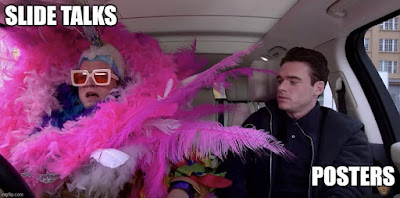If I was going to present this research by Francisco Guerrero at an academic conference, I would never want to give it as a slide talk.
Click to enlarge!
This single image along would make a great poster with very little change. And that’s because of the type of data visualization that is shown.
Here you have a single image that is quite rich. There are well over 100 data points in this grid, and to get the most out of it, you really have to look at it for a while. It helps to be able to come in to see some of the fine details, like the labels.
I just don’t think this graphic would work as well on a slide. There’s too much detail to absorb in the typical minute that a slide is on screen. I suppose you could try to break this down into a series of slides – one for each category on the Y axis, maybe – but that makes it hard to compare categories.
A poster would be the superior format for this kind of data. It would communicate more effectively.
Here’s an example of a data set that would be better broken down on a series of slides.
These eleven panels are probably much better presented as a series of eleven individual slides, where you can quickly address each one in isolation. Each one individually makes a complete point.
Too often, though, the decision whether to try to present a project as a talk or a poster is not based on the type of data shown. It’s based on criteria like:
- The career stage of the presenter. People earlier in their careers get posters, people later get the talks. I think there are many questionable assumptions about why this should be.
- The ego of the presenter. Some people just want to be on the stage. It’s fun to be the center of attention for a few moments. But it’s not focused on the needs of the audience.
If your project has a series of many experiments, each with its own results, push to give a talk even if this is your first academic conference.
If your project generates a single, high resolution visualization that contains a rich set of data, swallow your pride and do the right thing by your data. Give a poster.
Hat tip to Liz Neely for sharing the top graphic.









1 comment:
Hi Zen! Thanks a lot for featuring this content in your blog! I appreciate your time and thoughts on it! An important clarification here is that this is NOT my research and my job here was to create a visual for data that were presented originally as a table (this is a link to the original study by MacKrill et al: https://asistdl.onlinelibrary.wiley.com/doi/abs/10.1002/asi.24471). The audience for this visual is SciComm practitioners that would take the time to digest the correlations and extract many of the interesting messages found by the researchers in their study. For that reason I appreciated that Liz Neeley shared a link to the pdf to be downloaded and analyzed more carefully. I wonder if by sharing the viz. in a fast-paced channel like twitter creates the impression that the content should be absorbed at the same velocity you would absorb a slide (which is an interesting reflection for future shares). Anyway, thanks a lot! Take care!
Post a Comment